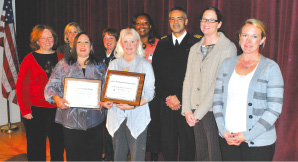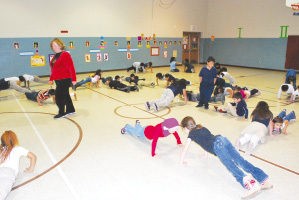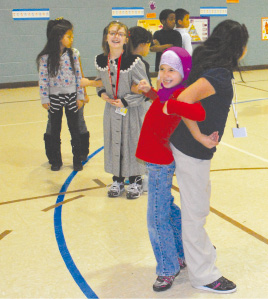
By Leslie Collins
Northeast News
January 11, 2012
When fourth grader Grace Knight first learned about eating healthy, she was less than enthused. She thought she’d never be able to eat candy again.
“That was really upsetting at first because I love candy,” the Gladstone Elementary student said. “But, I have good news. After my lessons with Miss Lindsay (a registered dietician), I learned I can still eat candy. There are just certain rules to follow to help me be healthy.”
Knight, along with the other second through sixth graders at Gladstone Elementary, began learning about nutrition through the Energy Balance 4 Kids (EB4K) program sponsored by the American Dietetic Association Foundation and the Healthy Weight Commitment Foundation. EB4K provides registered dietician coaches to schools to teach children about nutrition and the value of physical activity. The program, along with other changes made in the school, helped Gladstone earn the bronze award in the HealthierUS School Challenge (HUSSC). Hartman Elementary also earned the bronze.
“This is an award that really recognizes schools that make that extra effort and go that extra mile to make changes within the school environment and their policies around food,” said Kuda Chimanya, registered dietician with Kansas City’s EB4K.
Gladstone Elementary Principal Dana Carter said earning the award required a team effort that ranged from the cafeteria managers to the registered dieticians to the physical education teachers to the school district itself.
To qualify for the award, schools must submit an application and outline how they improved the school environment with physical activity, nutrition education and nutritious foods. Schools must also meet the USDA Food and Nutrition Service’s basic criteria, like providing fresh fruits and vegetables, whole grains and legumes.
“Once we learned about the HealthierUS School Challenge in 2010, we were very much interested in participating,” said Ellen Cram, director of nutrition for Kansas City Public Schools.
KCPS changed its breakfast and lunch menus at every school and ensured all its breads were whole wheat.
“That piece with whole grains alone impacted my budget by 3 percent,” Cram said.
School cafeterias also began serving whole wheat pasta, baked sweet potato fries, and offering a wider variety of fruits and vegetables.
“You cannot offer apple sauce and a fresh apple in the same week because that’s two apples. You have to offer variety,” Cram said. “They also want you to offer fresh fruits and vegetables.”
KCPS now serves fresh vegetables and fresh fruit at least twice a week. The most popular vegetable among students is the baby carrots, she said. Instead of offering only iceberg lettuce, the district now uses a romaine and iceberg mix to increase the nutrient value. In addition, school menus now include a weekly offering of beans and legumes, like baked beans and pinto beans.
While changing the menu has been a challenge, it’s one that’s worth it, she said.
“All of our schools are getting the benefit from the HealthierUS School Challenge dietary guidelines,” Cram said.
As for EB4K, it’s more than spouting off nutrition facts to students.
“I think it’s (program) brought excitement around nutrition and physical activity,” Chimanya said. “We’ve basically embedded the messages into the whole school environment as a surround sound effect.”
EB4K registered dieticians led interactive lessons, worked collaboratively with P.E. teachers to combine physical activity with nutrition education, and hung up educational posters in the hallways.
One example of a P.E. activity was the “Snack Calorie Burn-off.” Stations were set up throughout the gymnasium which ranged from making basketball shots to jumping jacks to hula hooping and more.
“They knew if they were at the hula hoop station and they decided to eat a brownie, they’d have to do 50 hula hoops or if they were at the basketball station, they’d have to shoot 50 hoops compared to if they ate baby carrots, they’d only have to do five hoops or jumping jacks,” Chimanya said. “We helped them understand the more calories you consume, the more you have to burn off if you decide to make that choice.”
Asked what she thought of EB4K, Carter said, “It’s absolutely fabulous. The kids were eager to do it. Thinking from a kids’ perspective, I didn’t think they would be excited about it, but oh my gosh, they loved it. They ate fruits and vegetables that they’d never had before.”
Carter added she hopes the program will leave a lasting impact, not only on the students, but on future generations.
“I hope it passes on to their kids,” she said. “I know it’s already passed on to their parents because parents are starting to say, “Oh, yeah, my kid won’t let me buy these potato chips anymore because they say they’re unhealthy.'”
Knight said she’s thankful her school could participate in the program and that she’s learned about “fabulous recipes” that are both “healthy and delicious.”
“It’s like a miracle,” Knight said of the changes in her school. “I see more people doing exercise at recess; I see more fruits in the cafeteria. I’m very proud of my school.”




















